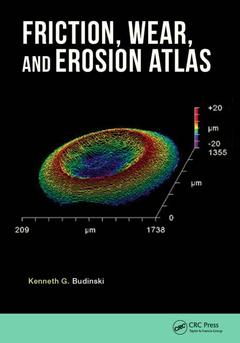Description
Friction, Wear, and Erosion Atlas
Language: English
Subjects for Friction, Wear, and Erosion Atlas:
Keywords
ASTM International; West Conshohocken; west; Standard Test Method; conshohocken; Material Removal; material; Rolling Element Bearings; removal; Solid Particle Erosion; solid; Adhesive Transfer; particle; ASM International; hard; Adhesive Wear; steel; Sliding Friction; adhesive; Surface Engineering Processes; astm; Rolling Friction; Slurry Erosion; Rolling Element; Chemical Mechanical Polishing; Rolling Contact Fatigue; Friction Force; Solid Particle Impingement; Cavitation Erosion; Liquid Erosion; Wear Mode; Corrosion Component; Titanium Carbide; Impact Wear; Stribeck Curve
Publication date: 11-2013
Support: Print on demand
Publication date: 04-2017
· 17.8x25.4 cm · Paperback
Description
/li>Contents
/li>Readership
/li>Biography
/li>
Friction, wear, and erosion are major issues in mechanical engineering and materials science, resulting in major costs to businesses operating in the automotive, biomedical, petroleum/oil/gas, and structural engineering industries. The good news is, by understanding what friction, wear, or erosion mode predominates in a mechanism or device, you can take action to prevent its costly failure.
Seeing Is Believing
Containing nearly 300 photos of component failures, macro- and micrographs of surface damage, and schematics on material removal mechanisms collected over 50 years of tribology consulting and research, Friction, Wear, and Erosion Atlas is a must-have quick reference for tribology professionals and laymen alike. Complete with detailed explanations of every friction, wear, and erosion process, the atlas? catalog of images is supported by a wealth of practical guidance on:
- Diagnosing the specific causes of part failure
- Identifying popular modes of wear, including rolling and impact, with a special emphasis on adhesion and abrasion
- Understanding manifestations of friction, such as force traces from a laboratory test rig for a variety of test couples
- Recognizing liquid droplet, solid particle, slurry, equal impingement, and cavitation modes of erosion
- Developing solutions to process-limiting problems
Featuring a glossary of tribology terms and definitions, as well as hundreds of visual representations, Friction, Wear, and Erosion Atlas is both user friendly and useful. It not only raises awareness of the importance of tribology, but provides guidance for how designers can proactively mitigate tribology concerns.
Introduction. Adhesive Wear. Abrasion. Rolling Contact Fatigue. Impact Wear. Lubricated Wear. Tribocorrosion. Solid Particle Erosion. Liquid Droplet Erosion. Sliding Friction. Rolling Friction. Materials for Wear and Erosion. Surface Engineering for Wear and Erosion. Solving Tribology Problems. Appendices.
Ken Budinski holds a BS in mechanical engineering from General Motors Institute (now Kettering University) in Flint, Michigan and an MS in metallurgical engineering from Michigan Technological University, Houghton, USA. He is a fellow in ASTM International, ASM International, and the Rochester Engineering Society, chair of the ASTM G02.5 Subcommittee on Friction, and a decorated technical contributor who has published over 50 journal papers and five other technical books. Formerly senior technical associate specializing in tribology at Eastman Kodak’s Materials Engineering Laboratory in Rochester, New York, he is now technical director for Bud Labs in Rochester.
These books may interest you

Introduction to Tribology 138.45 €



